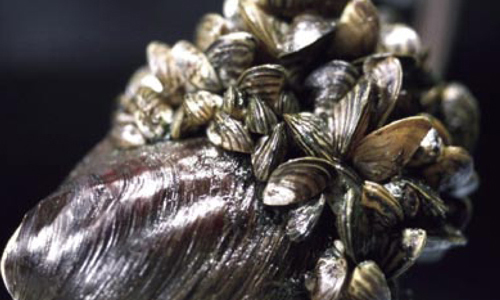Aquatic Invasive (Exotic) Species
Click here to download a PDF of this position statement
 Aquatic plant and animal species that are moved from lake-to-lake may be harmful. We are all aware of Aquatic Invasive Species (also called exotic or non-native species, with a lot of looseness in definitions). Here aquatic invasive species (AIS) is defined as an organism not previously found in a lake and not expected to have arrived solely as a function of natural processes, with the potential to become a dominant component of the aquatic system. As a general rule, AIS infestations are not desirable. Infestations in the Great Lakes have been given a lot of media time, but there are other modes of movement at other scales. Plants and animals that are not native to a lake may cause ecological disruption and harm. However, impacts of introduced species range from imperceptible and acceptable to widespread and devastating.
Aquatic plant and animal species that are moved from lake-to-lake may be harmful. We are all aware of Aquatic Invasive Species (also called exotic or non-native species, with a lot of looseness in definitions). Here aquatic invasive species (AIS) is defined as an organism not previously found in a lake and not expected to have arrived solely as a function of natural processes, with the potential to become a dominant component of the aquatic system. As a general rule, AIS infestations are not desirable. Infestations in the Great Lakes have been given a lot of media time, but there are other modes of movement at other scales. Plants and animals that are not native to a lake may cause ecological disruption and harm. However, impacts of introduced species range from imperceptible and acceptable to widespread and devastating.
What Are Aquatic Invasive Species and How do They Get Here?
AIS include plants and animals that are not native to a waterbody. AIS are harmful because they usually find themselves in an environment free from natural checks and balances. This means they often grow in large numbers or densities and may displace native plants and animals. Disruption of ecological processes, water supply, recreation and other water uses is possible and frequently observed.
Many people assume these introductions are accidental or unintended, but some are also intentional. From an ecological point of view, even non-native genetic strains of otherwise native species may be considered ‘exotic’ and harmful. Stocking for fishery purposes, release or escape after sale in the aquarium or horticultural trades, and dispersal in ballast water are common modes of transport considered outside the realm of normal natural processes for range expansion. Of course, some species arrive as a function of natural dispersal mechanisms, complicating the issue, but most of our aquatic problem species can be traced to inappropriate human actions.
Water gardening and aquarium stocking have also become a concern. Many potentially invasive plant and animal species can be purchased locally or by mail order, either because they are not regulated, or because many plants and animals are sold under common names and are easily confused or intentionally mislabeled. Viable hitchhikers, such as pathogens, snails, etc., are also a problem, many of which are invasive species. Surveys show that a large percentage of plants come mixed with other unintended plants and animals. The release of these invaders, either accidentally or intentionally, can have a significant impact on lakes.
Not a New Problem
Aquatic exotic species introductions are not a new problem, but they are a growing problem. Moving species was the excepted norm in many professions (fishery management, landscaping, agriculture) for the last century. People took what was known and native to them everywhere they went and brought exotic plants and animals back from their travels. Many public works projects also allowed for easy transport of AIS. Many notable AIS introductions occurred with the construction of the Welland Canal, which opened the Great Lakes to international shipping. One of the first fish introductions in the Great Lakes was the alewife, which proliferated and disrupted the commercial fisheries and washed up on shores during massive die-offs. There have been 179 known exotic plants and animals noted in the Great Lakes alone. Florida also has long been known as a gateway for AIS introductions, and has experienced hundreds of new species over the last century.
There have been many other AIS introductions on smaller scales in many other parts of North America. The common carp was introduced intentionally, thinking it would be a good food source. Purple loosestrife, water hyacinth, water lettuce were popular ornamental plants. Some AIS were introduced to get rid of other AIS, compounding the problem!
Now, exotic species introductions are occurring at greater rates and causing greater ecologic and economic impacts. National and international programs to curb these introductions are largely inadequate and ineffective. This means that state and local programs must play ‘catch-up.’ Local communities concerned about their lakes often feel helpless and frustrated. Until our overall response becomes more coordinated and comprehensive, these trends will continue and our lakes are in danger.
Issues & Concerns
- National and international policies and practices to slow or stop the introduction of new exotic species are not adequate.
- Prevention, monitoring and control must be coordinated at the international, national, state and local levels.
- The ecologic and economic impacts of exotic species introductions can be large.
- Inspection of boats entering lakes is an effective prevention and education tool, however, as a practical matter inspections do not often occur.
- Local protection and mitigation efforts are poorly supported in most cases.
NALMS Positions
- NALMS supports international and national efforts to restrict, control, monitor and mitigate exotic species movement.
- NALMS supports research in new control methods for exotic species.
- NALMS encourages and supports local efforts to protect lakes. This includes monitoring, inspections, education and mitigation programs.
Adopted by the NALMS Board of Directors on [November 7, 2005]
